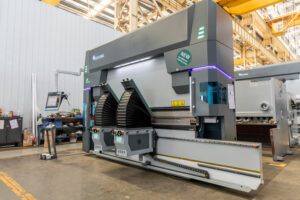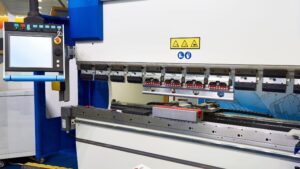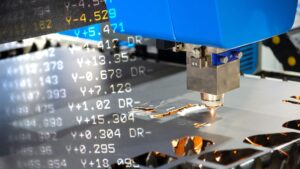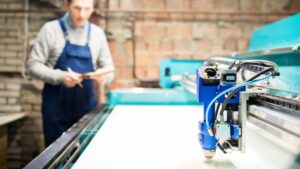Laser cutting, a marvel of modern manufacturing, harnesses the power of a concentrated laser beam to slice through materials with unmatched precision and speed.
This process not only revolutionizes how we create but also expands the horizons of design and production. At the heart of this innovation is the versatility in materials that can be laser cut, each offering unique benefits and applications.
From the robustness of metals to the delicacy of fabrics, laser cutting materials bring ideas to life in a form that is limited only by imagination.
What Materials Are Used for Laser Cutting?

The choice of materials for laser cutting spans a wide spectrum, each category presenting its own advantages and ideal use cases.
The selection of suitable materials for laser cutting includes metals, plastics, wood, glass, and textiles, each with its own set of properties that make it ideal for specific applications.
Understanding the characteristics of these materials is crucial for optimizing the laser cutting process and achieving the desired outcome.
Metals
Metals, with their durability and strength, are a popular choice for laser cutting. They require a laser cutters with higher power settings but offer precision and clean cuts for a variety of applications ranging from industrial components to intricate art pieces.
Stainless Steel
Stainless steel, known for its corrosion resistance and strength, is a favored material in laser cutting for producing durable industrial parts, art, and decorative items. Its ability to withstand harsh environments makes it ideal for outdoor applications, while its aesthetic appeal is perfect for artistic and decorative uses.
Mild Steel (Carbon Steel)
Mild steel, or carbon steel, combines strength with ease of cutting, making it a preferred material for automotive parts, construction beams, and artistic creations. It’s the go-to for projects requiring structural integrity and durability.
Aluminum
Aluminum, known for its remarkable lightness and resistance to corrosion, emerges as a top choice in laser cutting for industries where weight and durability are critical factors. Its lightweight nature, combined with significant strength, makes aluminum an indispensable material in aeronautics and automotive manufacturing. The material’s ability to resist corrosion extends the life of parts and products, making it also popular for creating intricate artworks that withstand the test of time.
Brass
Brass, an alloy of copper and zinc, boasts not only a visually appealing golden hue but also excellent conductivity, making it a preferred material for decorative items, plaques, and various components in the electronics industry. The aesthetic qualities of brass lend a touch of elegance to decorative pieces, while its conductivity ensures efficiency in electronic applications, from connectors to sensors.
Copper
Copper stands out for its superior conductivity and thermal properties, making it ideal for electrical components, decorative arts, and heat exchangers. Its high conductivity is critical for efficient energy transfer in electrical systems, while the warm, distinctive color of copper makes it a favorite among artists and designers. Additionally, copper’s thermal properties are leveraged in heat exchangers, contributing to systems that operate with greater energy efficiency.
Galvanized Steel
Galvanized steel, steel coated with a protective layer of zinc, is widely used in outdoor structures, HVAC systems, and automotive parts, thanks to its enhanced resistance to corrosion. This added layer not only extends the lifespan of structures and components exposed to the elements but also ensures the durability and integrity of HVAC systems and automotive components.
Titanium
Titanium, with its exceptional strength-to-weight ratio, is a metal of choice in aerospace, medical devices, and the automotive industry. Its unparalleled strength, coupled with its lightweight nature, makes titanium ideal for applications where both durability and weight reduction are crucial. Moreover, its biocompatibility makes it indispensable in the creation of medical implants and devices.
Nickel Alloys
Nickel alloys are renowned for their ability to withstand extreme temperatures, making them suitable for use in aerospace and chemical processing industries. These alloys maintain their strength and integrity even under high thermal stress, ensuring reliability in engines, turbines, and chemical reactors where performance at high temperatures is a necessity.
Precious Metals (Silver, Gold, Platinum)
Precious metals like silver, gold, and platinum are treasured not only for their intrinsic value but also for their workability and aesthetic appeal in laser cutting applications. These metals are predominantly used in the creation of fine jewelry and decorative items, where precision cuts and engravings add to their allure and value. The ability to laser cut these materials has opened up new avenues for intricate designs and customization in the luxury goods sector.
What Non-Metals Are Used for Laser Cutting?
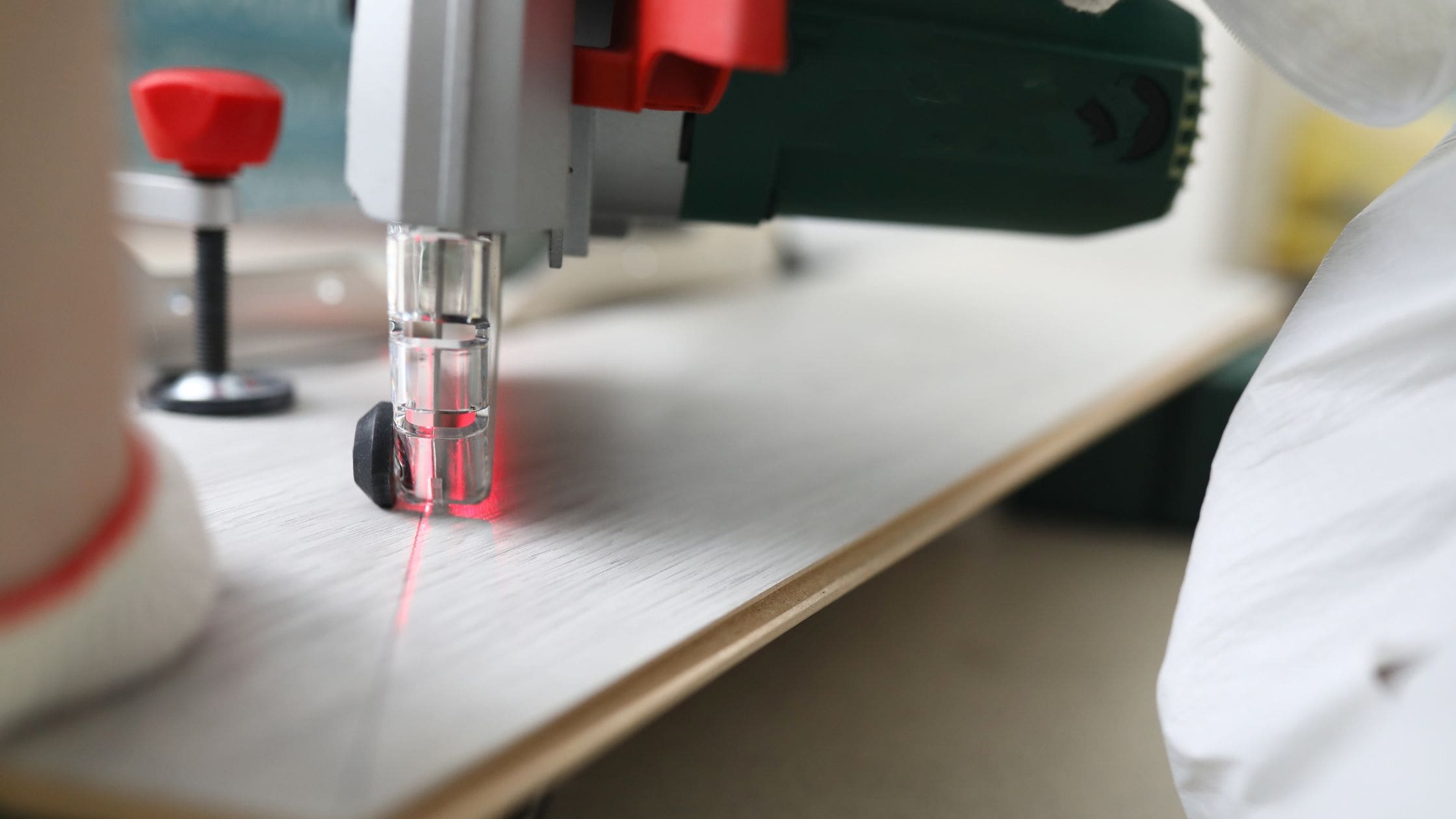
Transitioning from the world of metals, we delve into the realm of non-metals, which play an equally pivotal role in laser cutting. This technology, celebrated for its precision and versatility, is not limited to metals alone.
Non-metal materials, ranging from wood to acrylics and plastics, offer unique properties and advantages that make them ideal for a variety of applications in laser cutting.
Whether for artistic endeavors, functional prototypes, or intricate designs, understanding the suitability and applications of each non-metal material is key to unlocking the full potential of laser cutting.
Wood
Wood, in its many forms from plywood and MDF to balsa and hardwood, stands as a testament to the adaptability of laser cutting.
Each type of wood offers distinct characteristics; plywood and MDF are prized for their uniformity and ease of cutting, making them perfect for detailed crafts and furniture. Balsa, known for its lightness, is favored in model making.
Hardwoods, with their durability, are chosen for high-quality, lasting pieces. The laser’s ability to cut wood cleanly and with precision lends itself to endless creative and functional applications, from intricate crafts to robust furniture and detailed architectural models.
Acrylic (Plexiglass)
Acrylic, or Plexiglass, shines in the world of laser cutting for its clarity, versatility, and durability. Its ability to be cut into smooth, polished edges makes it a popular choice for signage, displays, and artistic applications.
Acrylic’s transparency and glossiness offer a visually appealing finish that mimics glass without the brittleness, making it a safer, more durable option for public and high-traffic areas.
The precision of laser cutting machines ensure that even the most intricate designs are executed flawlessly, allowing for creativity to flourish in commercial and artistic projects alike.
Plastics
Plastics like POM (Delrin), ABS, and polycarbonate are widely utilized in laser cutting for their diverse properties and applications. POM is known for its precision, dimensional stability, and resistance to wear, making it ideal for engineering components where tight tolerances are critical.
ABS combines toughness with heat resistance, suited for products that require durability and aesthetic appeal. Polycarbonate, notable for its impact resistance and clarity, is used in protective covers and signage.
Each of these plastics brings unique benefits to the table, enabling the creation of specialized components, signs, and models with laser cutting’s hallmark precision.
What Plastics Are Best for Laser Cutting?
When it comes to laser cutting, not all plastics are created equal. Materials such as POM, ABS, and polycarbonate stand out for their laser compatibility, offering a balance of cut quality, safety, and functional properties. Selecting the right plastic for laser cutting hinges on understanding the material’s reaction to the laser beam—some may produce cleaner cuts, while others might emit harmful gases or require specific laser settings. It’s imperative to choose plastics that not only meet the design and functional requirements but also align with safety standards, ensuring a successful and responsible laser cutting process.
Foams
Foam, with its lightweight and versatile properties, finds a special place in laser cutting applications. It’s commonly used for packaging, providing custom-fit protection for products of all shapes and sizes. Insulation is another area where foam’s properties are highly valued, offering solutions that are both effective and easily customizable.
In the realm of artistic models and prototypes, foam’s ease of cutting and shaping allows for the creation of intricate designs and structures. The laser’s ability to slice through foam cleanly and with high precision makes it an indispensable tool in both functional and creative projects.
Paper and Cardboard
Paper and cardboard are surprisingly versatile materials for laser cutting, allowing for the creation of intricate designs with precision.
The laser beam can delicately cut through these materials, producing clean and precise cuts ideal for intricate invitations, detailed art projects, and architectural models.
The low power settings required for these thin sheets prevent catching fire or damaging the material, making them an easy material to work with for laser cutting.
Fabric and Textiles
Fabric and textiles such as cotton, silk, and felt offer endless creative possibilities with laser cutting.
These materials are suitable for laser cutting because the laser beam can achieve clean cuts and beautiful engravings without fraying the edges, which is often a challenge with traditional cutting methods.
From fashion and interior design to unique art installations, laser cut fabrics bring a new dimension to creative projects, combining traditional materials with modern technology for innovative results.
Leathe
Leather is a favorite among laser cutting materials for creating high-quality fashion accessories, bags, and custom artwork. The laser cutter can engrave detailed patterns and cut precise shapes, adding a luxurious touch to the final product. Laser engraving on leather offers the ability to create unique textures, personalized monograms, and intricate designs, making each piece a work of art.
Rubber
Rubber is particularly well-suited for laser cutting when it comes to creating stamps, seals, and gaskets. The laser cutting machine can cut through rubber with high precision, producing clean edges and accurate shapes essential for these applications. Laser cut rubber items are durable, precise, and have a professional finish, ideal for both commercial and personal use.
What Specialty Materials Are Used for Laser Cutting?
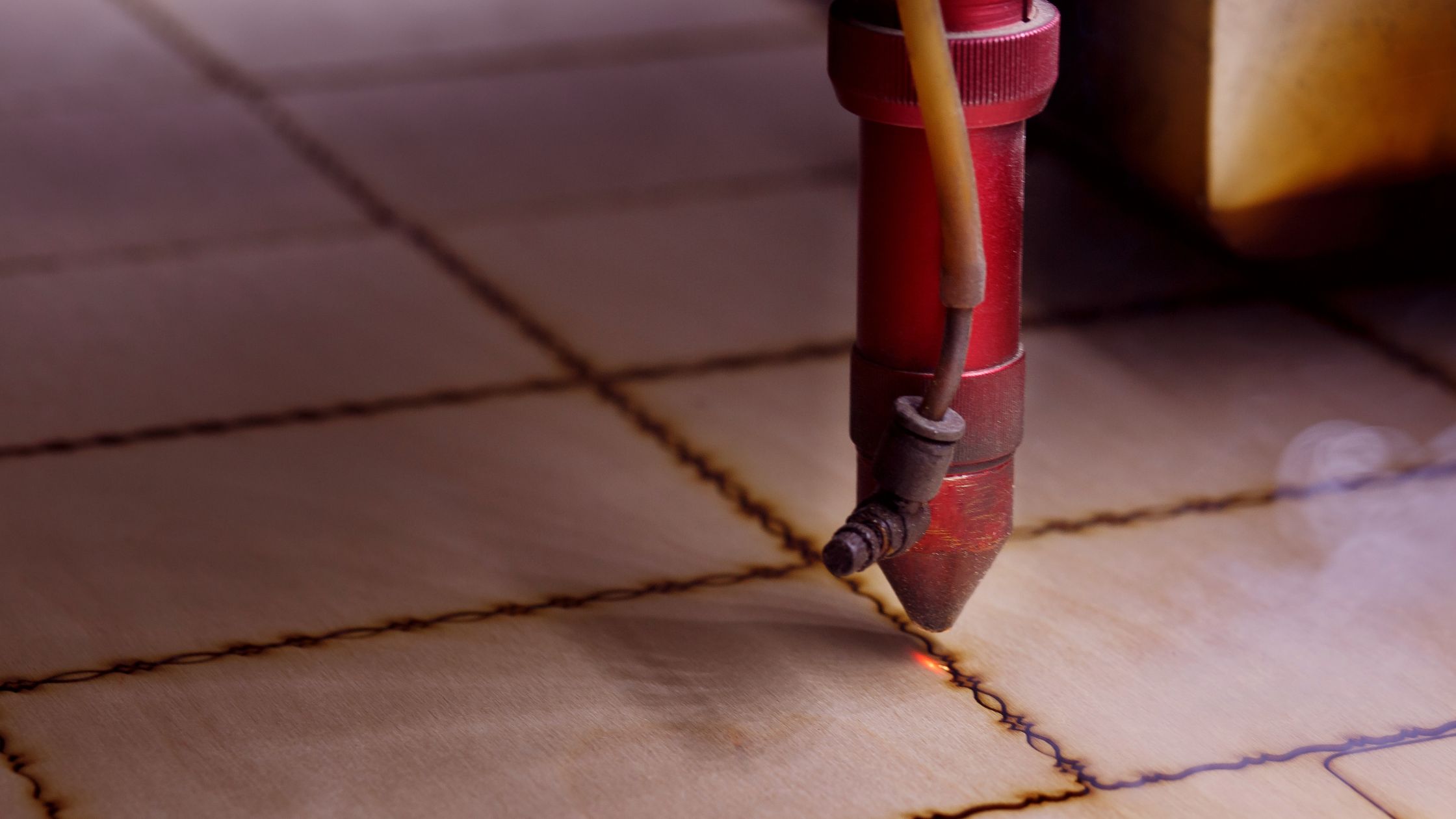
Beyond traditional non-metals, laser cutting also extends to specialty materials like glass, ceramics, stone, anodized aluminum, and laminates. These materials require specific laser types and settings but offer unique aesthetics and functionalities not achievable with other materials.
Glass
While cutting through glass with a laser cutter poses challenges, laser engraving glass is a popular application. This technique can create frosted appearances, intricate patterns, and detailed imagery for decorative purposes. The laser beam gently etches the surface, ensuring that the glass remains intact while achieving beautiful results.
Ceramics
Ceramics can be both cut and engraved with laser cutting machines, making them versatile for creating decorative tiles, art pieces, and certain industrial applications. The laser’s ability to etch detailed designs onto ceramic surfaces allows for the customization of tiles and dishes, adding a personal touch to home decor.
Stone
Stone, such as marble and granite, is mainly used for decorative etching with laser engraving. The laser cutter can create stunning contrasts on the stone surface, highlighting intricate designs, and lettering, ideal for monuments, plaques, and decorative home items.
Anodized Aluminum
Anodized aluminum, though a metal, is treated here for its specialty application in laser cutting for creating labels, plaques, and decorative items. The anodized layer allows for laser engraving to reveal the metal beneath, creating durable and visually appealing designs.
Laminates
Laminates, including engraving laminates, are designed specifically for laser cutting and engraving, perfect for signage, identification tags, and decorative panels. These materials are engineered to produce high-contrast engravings, offering clarity and durability for both indoor and outdoor applications.
What Materials Cannot Be Cut with Laser Cutting?
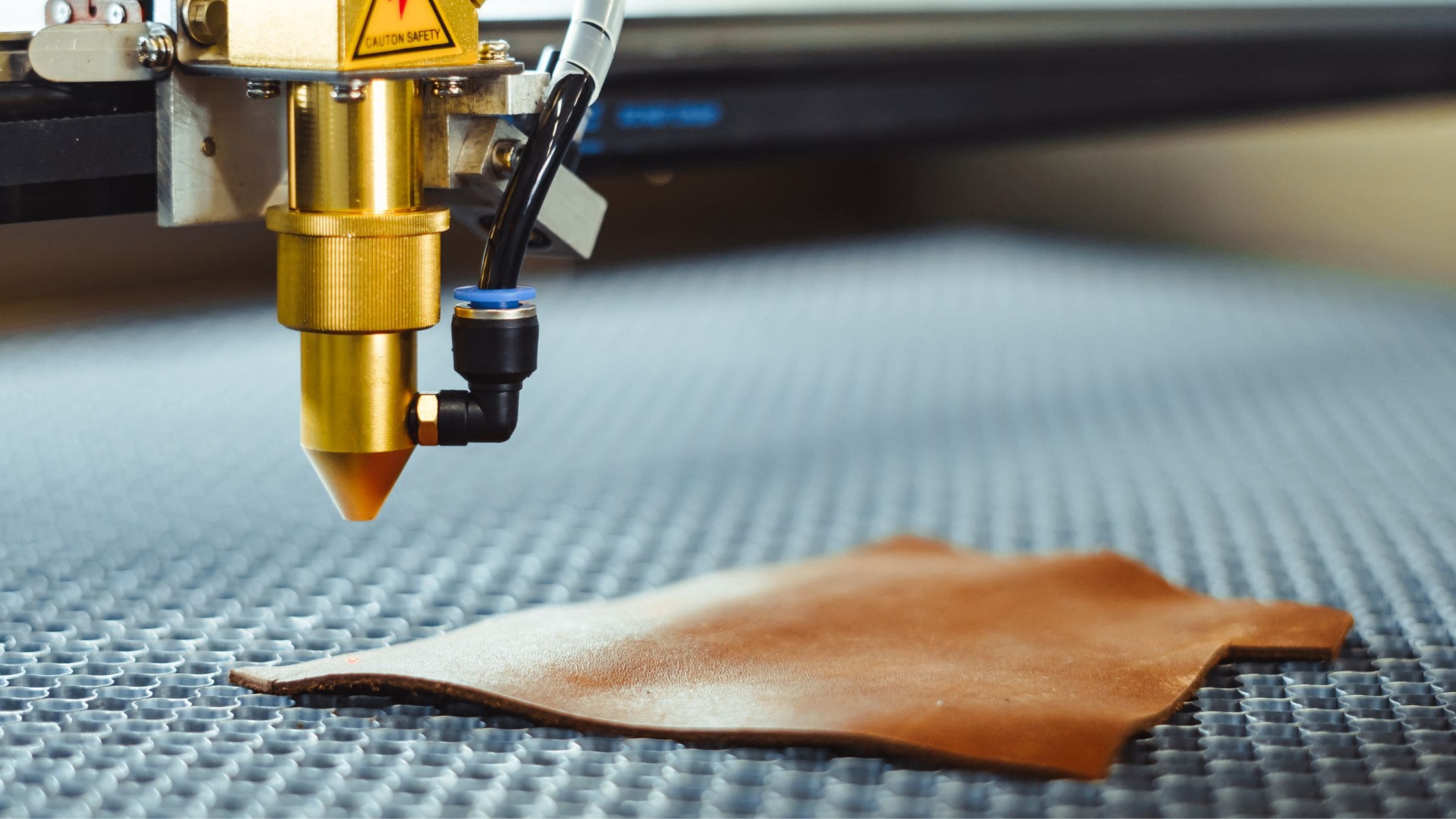
In the realm of laser cutting, not all materials are suitable or safe for use. Certain materials pose significant risks when exposed to the laser beam of a laser cutter, making them unsuitable or dangerous for laser cutting.
These materials can damage laser cutting machines, emit toxic fumes, or even catch fire, posing health and safety risks.
Let’s explore some of these materials and the reasons behind their unsuitability.
PVC (Polyvinyl Chloride) and Vinyl:
PVC and vinyl are materials that are particularly dangerous to cut using a laser cutter. When cut, they release chlorine gas, a hazardous substance that poses a significant health risk to humans and can corrode the interior of the laser machine, leading to costly damages. The emission of toxic fumes makes PVC and vinyl unsuitable for laser cutting, emphasizing the importance of good ventilation and material safety.
Polycarbonate: Tends to Discolor and Produces a Very Poor Edge Quality
Polycarbonate, while a versatile plastic, is not ideal for laser cutting, especially in thicknesses greater than 1mm. It tends to discolor, producing an unappealing yellowish hue along the cut edges. Additionally, polycarbonate cuts result in poor edge quality, with a lot of melted and re-solidified material, making it unsuitable for projects requiring precision and clean cuts.
ABS (Acrylonitrile Butadiene Styrene)
ABS plastic is known for its strength and durability in injection molding; however, it poses challenges in laser cutting. It’s prone to melting and warping, detracting from the quality of the final product. Moreover, ABS emits toxic fumes when cut with a laser, which can be harmful without proper ventilation, making it a less desirable material for laser cutting projects.
HDPE (High-Density Polyethylene)
HDPE, despite its widespread use in various products, is highly unsuitable for laser cutting. It has a tendency to melt, catch fire, and emit fumes that are not only harmful to humans but can also cause damage to the laser cutting machine itself. The risks associated with cutting HDPE make it a material to avoid in laser cutting applications.
Polypropylene Foam
Polypropylene foam is another material that poses significant risks in laser cutting. Its high flammability and tendency to melt easily can lead to uncontrollable fires and damage to both the material and the laser cutter. The safety hazards linked with cutting polypropylene foam underscore the importance of selecting the right materials for laser cutting.
Fiberglass: Releases Fumes That Are Dangerous to Inhale
Fiberglass, used in a variety of applications for its strength and durability, is hazardous when cut using a laser cutter. The cutting process releases fumes that are dangerous to inhale and can damage the respiratory system. Additionally, these fumes can corrode and damage the laser cutting machine, making fiberglass an unsuitable material for laser cutting.
Coated Carbon Fiber
Coated carbon fiber is not recommended for laser cutting due to the noxious fumes it emits and its high reflectivity. The emitted fumes pose health risks, while the material’s reflectivity can lead to the laser beam being reflected back into the laser cutter, potentially causing damage to the equipment.
Epoxy: Produces Hazardous Fumes When Cut
Epoxy resins, when subject to laser cutting, produce hazardous fumes that pose health risks and can damage the laser cutting machine. The risks associated with cutting epoxy make it an unsuitable choice for laser cutting projects.
Thick Polycarbonate (>1mm)
Thick polycarbonate sheets, greater than 1mm in thickness, are particularly prone to catching fire during the laser cutting process. Additionally, they emit thick, black smoke that can obscure the laser beam and damage the laser cutter, making them unsuitable for laser cutting.
PolyStyrene Foam: Catches Fire and Emits Toxic Fumes
PolyStyrene foam is highly flammable and, when cut with laser power, it catches fire easily and emits toxic fumes. The dangers associated with cutting PolyStyrene foam highlight the need for careful material selection in laser cutting.
Polyvinyl Butyral (PVB)
PVB, when cut with a laser, releases toxic fumes that pose health risks. The emission of harmful gases during the cutting process makes PVB an unsuitable material for laser cutting.
Artificial Leather (Containing PVC)
Artificial leather that contains PVC components releases harmful chlorine gas when cut with a laser, posing significant health risks and potential damage to the laser cutting machine.
Any Material Containing Halogens (Fluorine, Chlorine, Bromine, Iodine, Astatine)
Materials containing halogens are dangerous for laser cutting due to the toxic and corrosive gases they can release. These gases pose health risks and can corrode the internal components of the laser cutter, making such materials unsuitable for laser cutting.
Materials with Sticky Glue Backing
Materials with sticky glue backing can damage the laser cutter by leaving residues that are hard to clean and can interfere with the machine’s operation. The risk of damage to the equipment makes these materials unsuitable for laser cutting.
Foodstuffs
Foodstuffs are generally unsuitable for laser cutting due to unpredictable results and the potential to attract pests. The laser cutting process on food can also pose health risks due to contamination.
Materials Coated with Unknown Substances
Materials coated with unknown substances pose a risk as they may release toxic fumes or damage the laser cutting machine during the cutting process. The uncertainty surrounding these coatings makes such materials unsuitable for laser cutting.
Laser Types and Their Suitability for Different Materials
Each laser cutter employs a distinct laser beam technology, making it uniquely compatible with various materials for laser cutting.
From CO2 lasers to fiber lasers and diode lasers, the spectrum of possibilities widens with each type.
Here, we’ll delve into the characteristics of these lasers and their compatibility with different materials, ensuring you make an informed decision for your laser cutting needs.
CO2 Lasers
CO2 lasers are among the most versatile and widely used laser cutters in the industry. They operate by channeling a laser beam generated from a gas mixture through a series of mirrors, culminating in a powerful and precise cutting tool. CO2 lasers excel in working with a variety of non-metal materials, including:
- Wood: Achieving clean cuts and detailed engravings with minimal burning.
- Acrylic and plastics: Producing polished edges and intricate cuts, though precautions are necessary with plastics prone to emitting toxic fumes.
- Fabric and textiles: Cutting synthetic fabrics without fraying, suitable for both industrial and artistic applications.
- Paper and cardboard: Enabling precise cuts for intricate designs and models without causing fire risks with proper settings.
Their laser power makes them less suitable for cutting thicker metal sheets but highly effective for engraving on metal surfaces when used with a marking compound.
Fiber Lasers
Fiber lasers stand out for their proficiency in cutting metal materials. Fiber laser cutting generates a beam through an optical fiber, doped with rare-earth elements, resulting in a laser cutter with a significantly smaller focus diameter. This allows for cutting at higher speeds and with greater precision. Fiber lasers are particularly effective for:
- Metals: Excelling in cutting stainless steel, aluminum, brass, and copper with high efficiency and precision.
- Thin sheets of metal: Providing clean cuts with minimal kerf width, making them ideal for intricate designs and industrial applications requiring fine detail.
Though fiber lasers can cut non-metals, their full potential is realized with metal materials, where their high power and precision can be fully leveraged.
As a leading manufacturer, ACCURL is devoted to producing cutting-edge ultralight, high-precision and high-energy fiber laser cutters.
ACCURL fiber laser cutting machines are characterized by high dynamics and top quality. Our systems achieve a positioning speed of up to 180m/min and acceleration of 3G. Each fiber laser cutter is available with a 1 to 30kW IPG fiber laser source capable of cutting even the thickest metals with utmost accuracy.
Diode Lasers
Diode lasers represent a more compact and energy-efficient option, making them suitable for hobbyists and small-scale applications. A diode laser uses semiconductor diodes to generate a laser beam, offering a practical solution for:
- Thin materials: Excelling in cutting thin wood, leather, and some plastics without producing excessive toxic gases.
- Engraving: Capable of detailed engravings on wood, leather, and even some metals when used with appropriate coatings.
While diode lasers offer versatility, they are generally less powerful than CO2 and fiber lasers, limiting their effectiveness with thicker or more demanding materials.
How to Choose the Right Laser Cutter Based on Material?
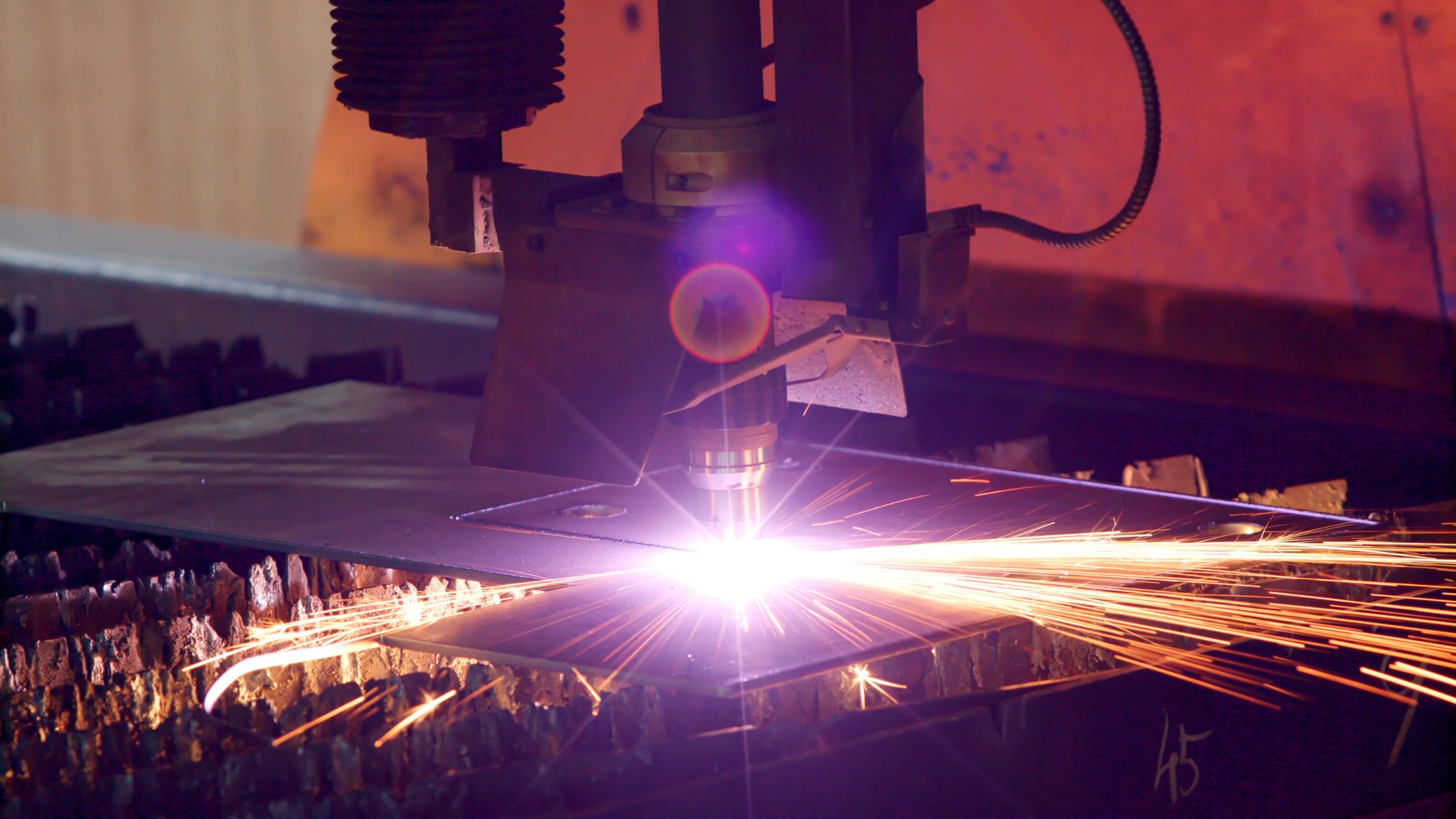
Choosing the right laser cutter for your specific needs involves a careful consideration of the materials you plan to cut, the precision required, the volume of work, and, of course, your budget. With various types of laser cutters on the market, including CO2 lasers, fiber lasers, and diode lasers, each offers unique benefits and is better suited for certain materials and applications.
Here are six critical factors to consider when selecting a laser cutter.
1. Material Compatibility
The foremost consideration in choosing a laser cutter is the material you intend to cut. Different laser types have varying capabilities when it comes to the range of materials they can effectively process.
- CO2 lasers are incredibly versatile, able to cut and engrave a wide range of materials, including wood, acrylic, fabric, and leather. However, they struggle with cutting metals without an added air assist system.
- Fiber lasers excel at cutting metal sheets, including stainless steel and aluminum, offering high precision and speed. They are not as effective with non-metal materials.
- Diode lasers offer a balance between CO2 and fiber lasers, capable of cutting thinner materials and engraving on both metals and non-metals, but with limitations in power and material thickness.
2. Material Thickness
The thickness of the materials you plan to cut is just as important as the type. Laser power is a critical factor here, measured in watts.
- Higher laser power (150 watts and above) is necessary for cutting through thicker materials like thick wood or metal plates.
- For thinner materials, such as paper, cardboard, or thin sheets of acrylic and fabric, a laser cutter with lower power (50 watts or less) can be sufficient.
3. Precision and Quality
The desired precision and quality of the cut also play a significant role in the selection process.
- Fiber lasers are known for their incredible precision, making them ideal for industries requiring high detail, such as electronics manufacturing.
- CO2 lasers offer a good balance of quality and versatility, suitable for a wide range of laser cutting applications needing clean edges and fine details.
4. Production Volume
Consider the volume of work you expect to process. High-volume projects require a laser cutter that is not only fast but also reliable over extended periods.
- Fiber lasers tend to have a faster cutting speed, especially for metal materials, making them suitable for high-volume production.
- CO2 lasers might be slower in comparison but are often more affordable, making them a good choice for small businesses or educational settings.
5. Budget Constraints
Your budget will undoubtedly influence your choice of laser cutter.
- Fiber lasers, while highly efficient for cutting metals, tend to be more expensive due to their advanced technology and components.
- CO2 lasers offer a more cost-effective solution for those who primarily work with non-metal materials.
- Diode lasers represent an even more budget-friendly option, especially for hobbyists or small-scale operations, but with limitations in capabilities and durability.
6. Safety and Ventilation
Lastly, the safety features of the laser cutter and the ventilation requirements for safe operation should not be overlooked.
- Materials like PVC and certain plastics can emit toxic fumes or chlorine gas when cut, necessitating good ventilation and air filtration systems.
- Ensure the laser cutter comes with built-in safety features to protect against fire, toxic gasses, and other hazards associated with laser cutting.
How Does Laser Cutting Settings and Parameters Change According to the Materials?
Selecting the right settings and parameters for laser cutting is crucial to achieving optimal results. This involves adjusting variables such as wattage, speed, max depth, and nozzle size to match the specific materials being cut.
Understanding how these settings impact the cutting process can help you choose the best laser cutter for your needs, whether you’re working with thin sheets that could catch fire or thick metals requiring high power.
Below is a table with common settings and their values for the most common laser cutting materials.
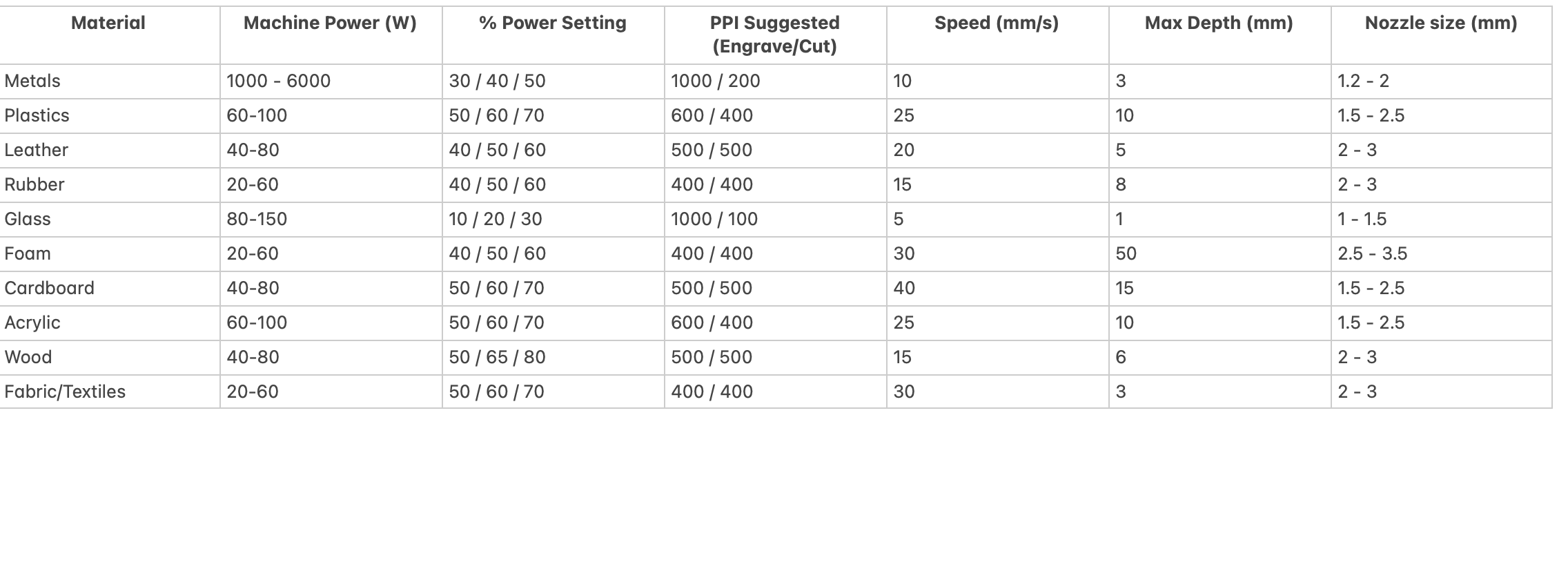
Keep in mind that these settings are based on general guidelines and may require adjustment
based on the specific characteristics of the material and the requirements of the cutting project. Testing and fine-tuning are recommended to achieve optimal results.
Conclusion
Mastering laser cutting requires a deep understanding of the interplay between laser types, materials, settings, and safety considerations. Whether navigating the nuances of CO2, fiber, or diode lasers, or adjusting parameters to seamlessly cut through wood, metals, or delicate fabrics, each decision impacts the outcome. Emphasizing the right materials and leveraging optimal settings are pivotal.
By meticulously selecting your laser cutter based on material compatibility, industry needs, and operational parameters, you can unlock the full potential of laser cutting, ensuring precision, efficiency, and safety in every project.


